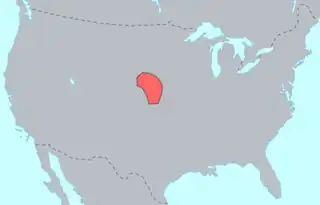| Pawnee | |
|---|---|
| Native to | United States |
| Region | North-central Oklahoma |
| Ethnicity | 2,500 Pawnee (2007) |
Native speakers | < 10 (2007)[1] |
Caddoan
| |
| Language codes | |
| ISO 639-3 | paw |
| Glottolog | pawn1254 |
| ELP | Pawnee |
| Linguasphere | 64-BAB-b |
 Pre-contact distribution of Pawnee | |
 Pawnee is classified as Critically Endangered by the UNESCO Atlas of the World's Languages in Danger | |
The Pawnee language is a Caddoan language traditionally spoken by Pawnee Native Americans, currently inhabiting north-central Oklahoma. Historically, the Pawnee lived along the Platte River in what is now Nebraska.
Dialects
Two important dialect divisions are evident in Pawnee: South Band and Skiri. The distinction between the two dialects rests on differences in their respective phonetic inventory and lexicon. The Skiri dialect became extinct in 2001 with the death of Lula Nora Pratt.[2]
Status
As of 2007, there are fewer than 10 native speakers, all elderly. the Pawnee Nation is developing teaching materials for the local high school and for adult language classes. There are also extensive documentary materials in the language archived at the American Indian Studies Research Institute.[3] The Pawnee language can be heard spoken in the 2015 movie The Revenant.[4] In 2019 and 2020, the Pawnee Nation posted online videos teaching the Pawnee language.[5]
Phonology
The following describes the South Band dialect.
Consonants
Pawnee has eight consonant phonemes, and according to one analysis of medial- and final-position glottal stops, one may posit a ninth consonant phoneme.
| Bilabial | Alveolar | Velar | Glottal | |
|---|---|---|---|---|
| Stop | p | t | k | (ʔ) |
| Affricate | ts | |||
| Rhotic | r | |||
| Fricative | s | h | ||
| Approximant | w |
- /ʔ/ is predictable when it occurs in the middle of words. However, since /ʔ/ is not completely predictable at the end of words, it may also need to be considered a phoneme.
Vowels
Pawnee has four short vowel phonemes and four long counterparts (also phonemic).
| Front | Back | |
|---|---|---|
| High | i/iː | u/uː |
| Mid-low | e/eː | a/aː |
Morphology
Pawnee is an ergative-absolutive polysynthetic language.
Alphabet
The Pawnee alphabet has 9 consonants and 8 vowels. The letters are relatively similar in pronunciation to their English counterparts.
Consonants
| Spelling | Sound (IPA) | English equivalents |
|---|---|---|
| p | p | poke, cup |
| t | t | top, cat |
| k | k | cool, stuck |
| c | ʃ ~ ts | shell, push ~ pants |
| s | s | silly, face |
| h | h | heart, ahead |
| r | r | car, ferry |
| w | w | wacky, away |
| ′ | ʔ | The "-" in uh-oh |
Vowels
| Spelling | Sound (IPA) | English equivalents |
|---|---|---|
| i | ɪ | sit |
| ii | i | feed |
| e | ɛ | red |
| ee | eɪ | paid |
| a | ʌ | nut |
| aa | ɑ | father |
| u | ʊ | book |
| uu | u | rude |
Notes
- ↑ Victor Golla, "North America.” In Moseley & Asher, Encyclopedia of the world's endangered languages
- ↑ Douglas Parks and Lula Nora Pratt (2008) A Dictionary of Skiri Pawnee
- ↑ "Pawnee".
- ↑ Nolan, Bethany. "IU linguists provide Arikara and Pawnee dialogue for Oscar-nominated film 'The Revenant'". Inside IU Bloomington. Retrieved 2019-07-24.
- ↑ YouTube user "Pawnee Nation". "Pawnee Language Classes - YouTube". www.youtube.com. Retrieved 10 May 2023.
References
- American Indian Studies Research Institute. (2008). Dictionary Database: Pawnee (Skiri and Southband dialects).
- American Indian Studies Research Institute. (2001). Pawnee Alphabet Book.
- Mithun, Marianne. (1999). The languages of Native North America. Cambridge: Cambridge University Press. ISBN 0-521-23228-7 (hbk); ISBN 0-521-29875-X.
- Parks, Douglas R. (1976). A grammar of Pawnee. New York: Garland.
- Taylor, Allan R. (1978). [Review of A grammar of Pawnee by D. Parks]. Language, 54 (4), 969-972.
External links
- Pawnee Language Program, sponsored by the Pawnee Nation and Indiana University